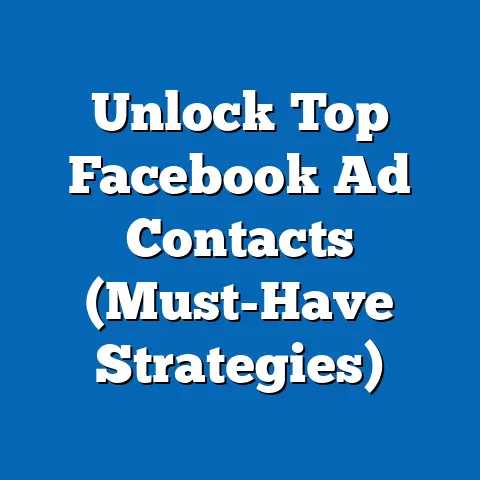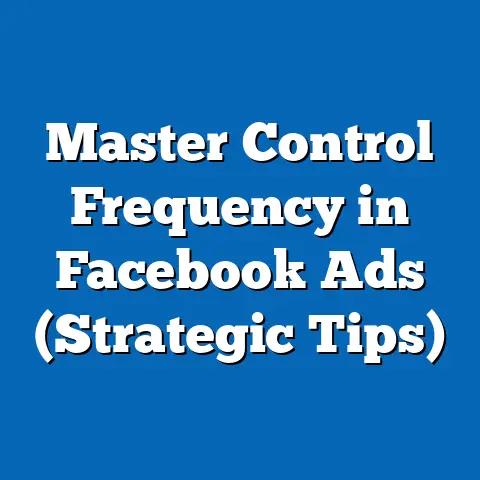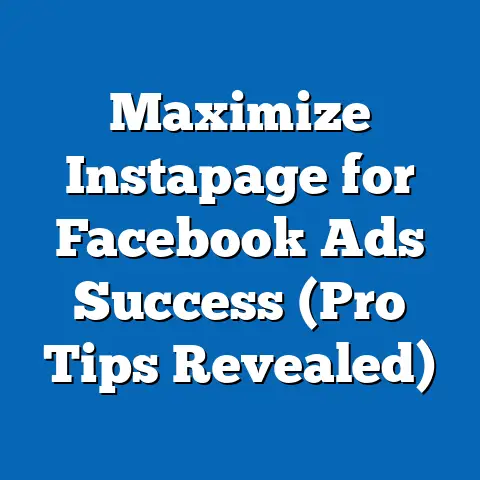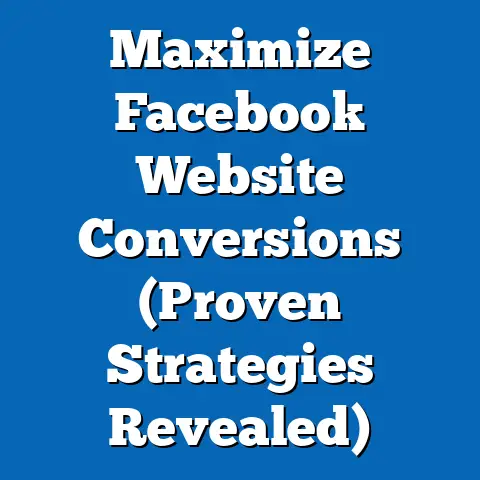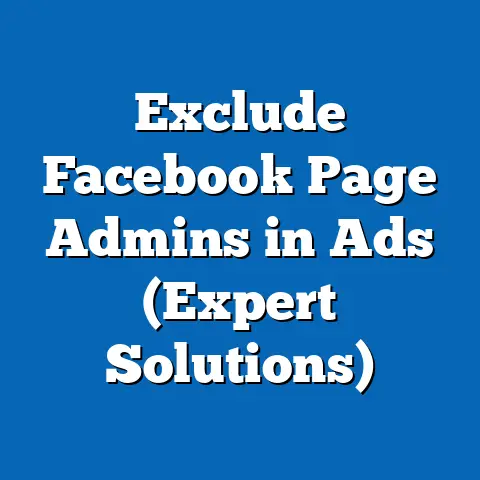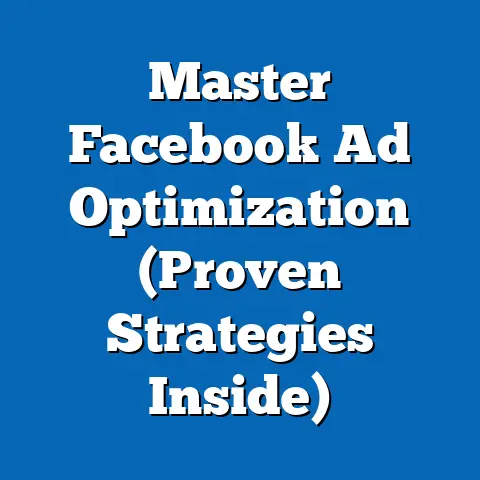Maximize ROI by Dividing Facebook & Instagram Ad Budget (Strategic Insight)
Imagine Sarah, a passionate artisan soap maker, struggling to keep her small business afloat. She poured her heart and soul into crafting unique, eco-friendly soaps, but reaching customers felt like shouting into a vast, empty room. Traditional marketing felt outdated and expensive. Then, she discovered the power of Facebook and Instagram ads. By strategically dividing her ad budget and tailoring her messages to each platform, Sarah transformed her business. Sales soared, brand awareness skyrocketed, and she built a loyal community of customers. This isn’t just a dream; it’s a reality achievable with the right approach to Facebook and Instagram advertising.
I’ve seen this story play out countless times in my years as a digital marketing specialist. Businesses, big and small, can unlock incredible growth by understanding how to effectively leverage these powerful platforms. The key? Strategic budget allocation.
Understanding the Facebook & Instagram Advertising Ecosystem
Facebook and Instagram, both under the Meta umbrella, offer unparalleled reach and targeting capabilities. However, they are not identical twins. They attract different demographics and foster distinct engagement styles.
-
Facebook: Boasts a broader demographic reach, appealing to a wider age range and diverse interests. It’s a powerful platform for building community, sharing in-depth content, and driving website traffic. Think of it as the town square – a central hub for news, information, and connection. Facebook offers a wide array of ad formats, from image and video ads to carousel and collection ads, catering to various marketing objectives.
-
Instagram: Skews younger, visually driven, and focused on lifestyle and aspirational content. It’s ideal for showcasing your brand’s personality, engaging with influencers, and driving product discovery. I think of Instagram as the stylish boutique – visually stunning and curated to inspire. Instagram’s strength lies in its visual storytelling capabilities, with formats like Stories, Reels, and Shoppable Posts offering immersive and engaging ad experiences.
Facebook: Boasts a broader demographic reach, appealing to a wider age range and diverse interests. It’s a powerful platform for building community, sharing in-depth content, and driving website traffic. Think of it as the town square – a central hub for news, information, and connection. Facebook offers a wide array of ad formats, from image and video ads to carousel and collection ads, catering to various marketing objectives.
Instagram: Skews younger, visually driven, and focused on lifestyle and aspirational content. It’s ideal for showcasing your brand’s personality, engaging with influencers, and driving product discovery. I think of Instagram as the stylish boutique – visually stunning and curated to inspire. Instagram’s strength lies in its visual storytelling capabilities, with formats like Stories, Reels, and Shoppable Posts offering immersive and engaging ad experiences.
Understanding these nuances is crucial. You wouldn’t use the same language to talk to your grandmother as you would to your Gen Z cousin, right? The same principle applies to your ad campaigns.
The Importance of ROI in Advertising
ROI, or Return on Investment, is the bedrock of any successful advertising campaign. It’s the metric that tells you whether your ad spend is generating a positive return. Simply put, it measures the profit you generate for every dollar you spend.
Why is ROI so important?
- Justifies Investment: ROI provides concrete evidence that your advertising efforts are working, justifying the investment of time and money.
- Informs Optimization: By tracking ROI, you can identify what’s working and what’s not, allowing you to refine your campaigns and maximize their effectiveness.
- Drives Growth: A positive ROI fuels business growth by generating revenue and increasing profitability.
According to recent studies, businesses that actively track and optimize their ROI in digital advertising experience, on average, a 20% increase in revenue. Ignoring ROI is like driving blindfolded – you’re bound to crash.
Strategic Budget Allocation: A Deep Dive
Now, let’s get to the heart of the matter: how to strategically divide your ad budget between Facebook and Instagram to maximize your ROI. This isn’t a one-size-fits-all solution; it requires a thoughtful approach based on your specific goals and audience.
1. Identify Your Audience
Before you even think about budget allocation, you need to deeply understand your target audience. Who are they? What are their interests? Where do they spend their time online?
- Facebook Audience Insights: Leverage Facebook’s built-in Audience Insights tool to gather valuable data about your target audience, including demographics, interests, behaviors, and purchase patterns.
- Instagram Insights: Similarly, Instagram Insights provides valuable information about your followers, including their age, gender, location, and the times they are most active.
- Customer Data: Don’t forget your own customer data! Analyze your existing customer base to identify common characteristics and preferences.
If your target audience is primarily young adults interested in fashion and lifestyle, Instagram might be your primary focus. Conversely, if you’re targeting older demographics or promoting a product with complex features, Facebook might be a better fit. I once worked with a local bookstore that thought Instagram would be their main platform. However, after analyzing their customer data, we found that their target audience was much more active on Facebook, engaging with book reviews and author interviews. We shifted the budget, and their sales skyrocketed.
2. Setting Clear Objectives
What do you want to achieve with your advertising campaigns? Are you aiming to:
- Increase Brand Awareness?
- Generate Leads?
- Drive Website Traffic?
- Boost Sales?
Your objectives should be SMART: Specific, Measurable, Achievable, Relevant, and Time-bound.
- Brand Awareness: Allocate a larger portion of your budget to platforms with wider reach, such as Facebook, and focus on visually engaging content that captures attention.
- Lead Generation: Target platforms where your audience is most likely to engage with your lead magnets, such as Facebook, and optimize your ads for lead form submissions.
- Drive Website Traffic: Use compelling ad copy and visuals to entice users to click through to your website, and allocate your budget to platforms that drive the most qualified traffic.
- Boost Sales: Focus on platforms with strong e-commerce capabilities, such as Instagram Shopping, and target users who are most likely to convert into paying customers.
For example, if you’re launching a new product and your primary goal is to generate buzz and increase brand awareness, you might allocate a larger portion of your budget to Instagram, leveraging visually appealing content and influencer collaborations. On the other hand, if you’re running a limited-time promotion and your goal is to drive immediate sales, you might focus your budget on Facebook, targeting users with specific purchase intent.
3. Performance Metrics
Tracking the right KPIs (Key Performance Indicators) is essential for assessing the effectiveness of your ad spend on both platforms. Here are some key metrics to monitor:
- Reach: The number of unique users who saw your ad.
- Impressions: The number of times your ad was displayed.
- Click-Through Rate (CTR): The percentage of users who clicked on your ad after seeing it.
- Conversion Rate: The percentage of users who completed a desired action, such as making a purchase or filling out a form, after clicking on your ad.
- Cost Per Acquisition (CPA): The cost of acquiring a new customer through your advertising efforts.
- Return on Ad Spend (ROAS): The revenue generated for every dollar spent on advertising.
Facebook Ads Manager and Instagram Insights provide comprehensive analytics dashboards that allow you to track these metrics in real-time. I recommend setting up custom dashboards to monitor the KPIs that are most relevant to your business goals. Regularly analyze your performance data to identify trends, patterns, and areas for improvement. Don’t be afraid to experiment with different ad formats, targeting options, and bidding strategies to optimize your campaigns for maximum ROI.
Case Studies: Success Stories of Budget Division
Let’s look at some real-world examples of businesses that have successfully maximized their ROI by strategically dividing their ad budget between Facebook and Instagram.
Case Study 1: Local Coffee Shop
- Challenge: A local coffee shop struggled to attract new customers and compete with larger chains.
- Strategy: They divided their ad budget, focusing on Facebook for targeting local residents with promotions and events, and Instagram for showcasing visually appealing coffee creations and the shop’s cozy atmosphere.
- Budget Division: 60% Facebook, 40% Instagram
- Outcome: A 30% increase in foot traffic, a 20% rise in online orders, and a significant boost in brand awareness within the local community.
Case Study 2: Online Clothing Boutique
- Challenge: An online clothing boutique wanted to reach a younger audience and increase sales of their latest collection.
- Strategy: They allocated a larger portion of their budget to Instagram, leveraging influencer collaborations and visually stunning ad campaigns showcasing their clothing in lifestyle settings. They used Facebook for retargeting website visitors and running targeted promotions.
- Budget Division: 30% Facebook, 70% Instagram
- Outcome: A 45% increase in website traffic, a 35% rise in sales, and a significant boost in brand engagement among their target audience.
Case Study 3: B2B Software Company
- Challenge: A B2B software company aimed to generate qualified leads for their enterprise solution.
- Strategy: They focused their budget on Facebook, targeting professionals with specific job titles and interests. They created informative ad campaigns showcasing the benefits of their software and offering free demos.
- Budget Division: 80% Facebook, 20% Instagram (primarily for brand awareness)
- Outcome: A 50% increase in qualified leads, a 25% rise in demo requests, and a significant improvement in their sales pipeline.
These case studies highlight the importance of tailoring your budget allocation strategy to your specific business goals and target audience.
Tips for Effective Budget Division
Here are some actionable tips to help you divide your ad budget effectively:
- Test and Iterate: Start with a small budget and test different ad formats, targeting options, and bidding strategies on both platforms. Analyze your results and iterate based on what’s working best.
- Consider Seasonal Trends: Adjust your budget allocation based on seasonal trends and promotional periods. For example, you might increase your budget on Instagram during the holiday season to capitalize on increased shopping activity.
- Monitor Audience Engagement: Pay attention to how your audience is engaging with your ads on both platforms. If you notice that engagement is higher on one platform, consider shifting more of your budget to that platform.
- Use Retargeting: Implement retargeting campaigns to reach users who have previously interacted with your website or ads. This can be a highly effective way to drive conversions and maximize your ROI.
- Don’t Be Afraid to Experiment: The digital marketing landscape is constantly evolving, so don’t be afraid to experiment with new strategies and technologies. Stay up-to-date on the latest trends and best practices to ensure that your campaigns are always performing at their best.
Conclusion
Strategic budget allocation is the key to unlocking the full potential of Facebook and Instagram advertising. By understanding your audience, setting clear objectives, tracking the right metrics, and continuously optimizing your campaigns, you can maximize your ROI and drive significant growth for your business. Don’t let your ad budget go to waste; take the time to assess your current strategies and make adjustments based on the insights shared in this article. The results, like Sarah’s soap business, can be truly transformative.
Now, I’d love to hear from you. What are your experiences with Facebook and Instagram ad budgeting? Share your insights and questions in the comments below! Let’s learn and grow together.

